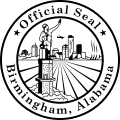
Back Birmingham, Alabama Afrikaans Birmingham (Alabama) AN Beormingaham on Ælebæman ANG برمنغهام (ألاباما) Arabic برمنجهام (الاباما) ARZ Birmingham (Alabama) AST Birminqem (Alabama) Azerbaijani برمینقم، آلاباما AZB Бирмингем (Алабама) Bashkir Бірмінгем (Алабама) Byelorussian
Birmingham | |
|---|---|
|
| |
| Nicknames: "The Magic City", "Pittsburgh of the South" | |
 Interactive map of Birmingham | |
| Coordinates: 33°31′03″N 86°48′34″W / 33.51750°N 86.80944°W | |
| Country | United States |
| State | Alabama |
| Counties | Jefferson, Shelby |
| Incorporated | December 19, 1871 |
| Named after | Birmingham, England |
| Government | |
| • Type | Mayor – Council |
| • Mayor | Randall Woodfin (D) |
| Area | |
• City | 149.54 sq mi (387.31 km2) |
| • Land | 147.02 sq mi (380.77 km2) |
| • Water | 2.52 sq mi (6.53 km2) |
| Elevation | 597 ft (182 m) |
| Population | |
• City | 200,733 |
• Estimate (2024)[3] | 196,357 |
| • Rank | 131st in the United States 2nd in Alabama |
| • Density | 1,365.37/sq mi (527.17/km2) |
| • Urban | 774,956 (US: 58th) |
| • Urban density | 1,521.7/sq mi (587.5/km2) |
| • Metro | 1,192,583 (47th) |
| • Combined | 1,376,853 (US: 43rd) |
| Demonym | Birminghamian |
| Time zone | UTC−6 (CST) |
| • Summer (DST) | UTC−5 (CDT) |
| ZIP Codes | 35201-35224, 35226, 35228-35229, 35231-35238, 35242-35244, 35246, 35249, 35253-35255, 35259-35261, 35266, 35270, 35282-35283, 35285, 35287-35288, 35290-35298 |
| Area codes | 205, 659 |
| FIPS code | 01-07000 |
| GNIS feature ID | 2403868[2] |
| Website | birminghamal.gov |
Birmingham (/ˈbɜːrmɪŋhæm/ BUR-ming-ham) is a city in the north central region of Alabama, United States. It is the second-most populous city in the state with a population of 200,733 at the 2020 census and estimated at 196,357 in 2024,[3] while the Birmingham metropolitan area with over 1.19 million residents is the largest metropolitan area in Alabama and 47th-most populous in the US.[5] Birmingham serves as a major regional economic, medical, and educational hub of the Deep South, Piedmont, and Appalachian regions. It is the county seat of Jefferson County.
Founded in 1871 during the Reconstruction era, Birmingham was formed through the merger of three smaller communities, most notably Elyton. It quickly grew into an industrial and transportation center, with a focus on mining, steel production, and railroads. Named for Birmingham, England, it developed with a labor force that included many African Americans from rural Alabama, often employed under non-union conditions.[6] Its rapid industrial growth from 1881 to 1920 earned it the nicknames "The Magic City" and "The Pittsburgh of the South." Though the prominence of mining and heavy industry declined in the late 20th century, Birmingham remains a significant manufacturing center with a diverse economy in banking, telecommunications, transportation, medicine and higher education.
The Birmingham area serves as headquarters to Fortune 500 companies Regions Financial and Vulcan Materials Company, along with multiple other Fortune 1000 companies. The University of Alabama at Birmingham, established in 1969, includes a prominent medical school, dental school, and other professional programs, making it one of the state's leading research institutions. The area also hosts private colleges such as Samford University and Miles College, along with Jefferson State Community College and Lawson State Community College. Birmingham is also home to the headquarters of the Southeastern Conference (SEC) and Southwestern Athletic Conference (SWAC), reinforcing its cultural and athletic influence in the region.
- ^ "2020 U.S. Gazetteer Files". United States Census Bureau. Retrieved October 29, 2021.
- ^ a b U.S. Geological Survey Geographic Names Information System: Birmingham, Alabama
- ^ a b c "U.S. Census Bureau QuickFacts: Birmingham city, Alabama; Huntsville city, Alabama; Mobile city, Alabama; Montgomery city, Alabama". United States Census Bureau. Retrieved May 27, 2025.
- ^ "2024 Population and Housing State Data". United States Census Bureau. Retrieved October 25, 2024.
- ^ "2020 Population and Housing State Data". United States Census Bureau. Retrieved October 25, 2021.
- ^ The Most Segregated City in America: City Planning and Civil Rights in Birmingham, 1920–1980, p. 14.









